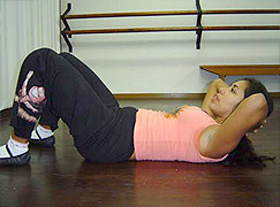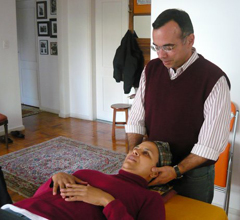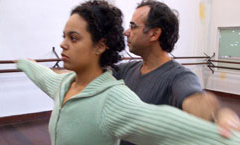"The Alexander Technique doesn't teach you something new to do. It teaches you how to bring more practical intelligence into what you are already doing: how to eliminate stereotyped responses: how to deal with habit and change.". Frank Pierce Jones, Tufts University

Why do we become more curved, slower and heavier with the passing of the years?
It is accredited to the agitated life we live, to work and old age. Or perhaps it is due to a specific moment, of excess weight or exhausting work. We never tend to think that it is something that we cultivate along the life we live and that it only worsens as the years go by.
Have you ever observed how long we remain in the same position during the day? For instance, how many hours we are seated, be it in front of the television or of the computer or in the office? The fact that we repeat, day after day, determined positions for hours on end, affects our ability to observe how we are using our body. This mechanical repetition creates the conditions for the installation and crystallization of bad postural habits. Without self-observation, we deteriorate our physical structure along the years thus causing pains and illnesses so common nowadays such as, muscular stiffness, back pains, stiff necks, breathing difficulties, constant physical and mental fatigue, discouragement, etc.
These bad habits tend to persist and are not corrected with a simple and direct method, or through certain kinds of treatments, but through a process of re-education. Learning Alexander's Technique's can stimulate self-observation of your daily routine preventing the crystallization of these bad postural habits and their harmful effects on the organism.
http://news.bbc.co.uk/go/em/fr/-/2/hi/health/7568948.stm
http://www.timesonline.co.uk/tol/life_and_style/health/article4568602.ece
http://www.guardian.co.uk/lifeandstyle/2008/aug/21/healthandwellbeing
http://www.telegraph.co.uk/news/2585404/Alexander-posture-technique-most-effective-at-reducing-back-pain.html
"Through the Alexander Technique I was able to rehabilitate my running after 25 years of being unable to run through injuries, to the extent that I was able to set ten world records for veterans in 1982." Paul Collins, marathon runner

O desequil�brio da cabe�a causado pelo excesso de tens�o do pesco�o no exerc�cio f�sico pode sobrecar-regar a coluna vertebral e trazer uma s�rie de problemas.

A TA pode fazer com que o corpo esteja bem organizado durante a atividade f�sica, sem causar preju�zo para a sa�de.
Alexander Technique can be of great benefit to athletes and all that practice any physical activities. Alexander discovered that most of the people have a faulty sensory appreciation in their kinetic perception (kinesthesia is the sense by which one notices the muscular movements, the weight and the position of the body in space). This means having a wrong perception as to how much muscular effort is necessary to perform a certain physical activity or to simply maintain an upright posture. This faulty sensory appreciation can put at risk the stability of the body itself, because without an exact notion of these limits, work overloads can lead to problems like muscular strain, stiffness of the neck, poor performance, joint lesions, wearing of the vertebral disks, amongst others.
Alexander's Technique lessons can recover the precision of the sensations we have of our body and its movement, creating the conditions for a balanced posture, freer reathing, mobility of the joints and the appropriate use of muscular tonus in different physical activities. With economy and precision of the neuromuscular activity the sportsman can reach better results in his performance.
"The things that don't exist are the most difficult to get rid of." F.M. Alexander

Stress is a response to certain stimuli that we receive every second, small and unpredictable problems that occur without prior preparation. When these stimuli occur, we create a series of neuro-muscular reactions as a response to them. The problem is that due to psychophysical disorganization that we acquire along life, we tend to respond to these stimuli with excess of tension and effort. They remain active in us independent from our present state and even after we have solved such problems. We end up always reacting with conditioned responses to everyday problems. They are responses that do not allow a healthy adaptation in a world that is each day growing faster.
In the Alexander Technique lessons, the student can learn to identify and inhibit certain patterns of habitual response, in this way, stimulating the choice of new responses in situations in which the individual is involved.
"A series of problems such as a constant hoarseness made me discover that I needed to learn how to use the body - I made unnecessary effort to speak and kept limiting postures, like shrinking my neck that shortened my breath and affected my voice. Alexander's Technique is only a process: we learn what not to do, how to alleviate tension and how to move freely allowing the flow of energy" Camila Pitanga, actress
Juliette Binoche talks about Alexander Technique
The actor needs to be aware of their main instrument: themselves. It is through them, the use of their body, their voice and of their emotions, that an actor gives life to his character.
So for the actor to choose, he must be free from the habits that interfere in his choices. If patterns of movement, breathing and of the use of the voice, are habitual and unconscious to the actor, he cannot make choices about the life of the character without creating distortions and unneeded efforts in himself to make these choices.
Institutions like universities and theater schools are including the Alexander Technique as part of their curricula as a base for creative exploration, health improvement, mental clarity, understanding and expansion of human potential.
Juilliard School, Dartington College of Arts, Yale School of Drama, Stella Adler Studio of Acting and Actors Studio are some of them. In England, the Alexander Technique is popular in an actor's curriculum and training as a professional and in Brazil follows a world trend and has been applied to actors during rehearsals, bringing greater economy and precision to their movements, as well as giving the actor more creative freedom.
Some quotes about Alexander Technique from theatre people:
"Every actor plays from his own body. The Alexander Technique gives you the control over your body so your body can express the character which is the most important aspect of interpretation." Stella Adler
"Of all the disciplines that form the actor training program, none is more vital, enriching and transformative than the Alexander Technique." Harold Stone, Associate Director, The Juilliard School, Drama Division
"The Alexander Technique helped a long-standing back problem and to get a good night�s sleep after many years of tossing and turning." Paul Newman
"I find the Alexander Technique very helpful in my work. Things happen without you trying. They get to be light and relaxed. You must get an Alexander teacher to show it to you." John Cleese
"I was dubious about the effects of the Alexander Technique when I first went in to experience it, but I found out almost immediately that the benefits were total - both physically and mentally - and, happily, have also been long-lasting." Joanne Woodward
"The Alexander Technique has helped me to undo knots, unblock energy and deal with almost paralysing stage fright." William Hurt
"Good acting is revealing yourself, not covering yourself up. If your body is free, your mind is free. [The AT allows] you to feel what it's like to stay open physically, and also stay fully involved in whatever you're supposed to be doing." Annette Bening
"The Technique's many benefits for actors include minimized tension, centeredness, vocal relaxation, and responsiveness, mind/body connection and about an inch and a half of additional height." Kevin Kline
"You cannot separate your voice use from the rest of you. The impulse to communicate vocally comes from and uses your whole person,, not merely the vocal organs. And however your mechanical use is affected, so is your voice which is an expression of yourself..."Michael McCallion � The Voice Book

The Alexander Technique is not a voice work and nor does it exclude the need for specific singing training, but it is an instrument that the artist may use to improve and to enhance his performance. It allows your voice to be the full expression and organization of yourself rather than resulting from tension and distortion.
What can be more distressful for an artist than the sensation of physical discomfort, to be able to sing for a day and not another, to feel neck pains and internal pressure, to have breathing difficulties and not to know what is happening? Why is it sometimes so easy and pleasant and, at other times, no matter how much you try, does not happen? How is my voice today? Know more about Alexander Technique and Singers
Te Alexander Technique does not try to do something new, but to give the opportunity of certain habits that interfere in the performance not to repeat themselves.
"As a ballerina, I was used to taking my body to the maximum limit and through Alexander Technique's classes I learned the importance of stopping and observing. The understanding of the appropriate use of the energy, of the muscular tonus, and of the intention in the performance of the movements brought more subtileness, freedom and integrity to my way of moving and dancing."Jaqueline Gimenez - Grupo Corpo's former ballarina

Throughout life we suffer several influences from our surroundings and independent from what qualities they possess, these influences mold our posture and movement. Before the ballet dancer executes a dance movement, all these acquired influences and automations in his body manifest themselves and telegraph movement. One of the advantages of the Alexander Technique for the ballet dancer is to bring attention to the moment that precedes movement, while body and mind organize themselves to execute a certain task.

There are a series of psico-physical reactions between stimulus and response that are normally automated. These reactions can limit the ballet dancer's performance once automated responses interfere in the natural flow of movement, what makes the workload greater. You will not be able to move freely if your body is limited. This explains why it is so widespread that without excessive muscular effort the results are poor.
Know more about Dance and the Alexander Technique.
"Forty years ago, after one of my concerts, Adrian Boult told me that I would be crippled if I continued to conduct in a specific manner, and that I should take Alexander Technique classes. Today still I take Alexander Technique lessons, as well as music; the learning process is endless. Not only does it affect the use of the body but also your self-image and behavior. The Technique can make miracles for those who experience pain and difficulties that come with time." Colin Davis, main conductor of LSO - BBC Music Magazine



The Alexander Technique is a practical method of re-education and is applied in conservatories, universities, orchestras and music festivals around of the world. It teaches us how to use our main work instrument: ourselves. Muscular strain, problems in the joints, restriction of the movement in the arms and legs, lack of muscular control, breathing impairments, poor performance, mental confusion and stage fright are quite common due to the excess of rehearsals, inadequate postures, uncomfortable chairs and stools, among others.
In the classes, the musician learns to observe how the body and mind work integrated, preventing noxious habits that are accumulated along life and that interfere in the evolvement and performance.
Know more about the musicians and the Alexander Technique.